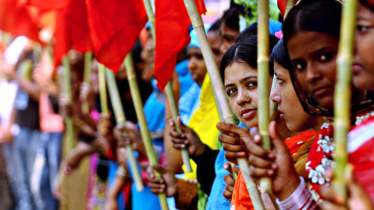
Photo : Messenger
Introduction
Bangladesh is a riverine country, with over a hundred rivers flowing through it. The country's climate and agriculture heavily depend on the flow and natural course of these rivers. However, over the past few decades, Bangladesh has been continuously facing floods, with the Farakka Barrage being a major contributing factor.
Since the gates of India's Farakka Barrage were opened, the flood situation in Bangladesh has taken on a new dimension. The Farakka Barrage, an internal climate control project built on the Ganges River, is causing severe flooding in northern and central Bangladesh. This decision by the Indian authorities has become a significant challenge for the people of Bangladesh, necessitating a precise analysis of the resulting situation.
Farakka Barrage: History and Impact
The Farakka Barrage was constructed in 1975 with the aim of ensuring the navigability of the Kolkata port and managing the flow of the Ganges River. However, since its construction, it has had a considerable impact on the rivers and environment of Bangladesh. Primarily, controlling the flow of the Ganges has altered the flow of rivers like the Padma, Jamuna, and others, which has affected the river systems and agricultural practices in Bangladesh.
Causes and Situation of Floods
Flooding is a natural phenomenon in Bangladesh, occurring mainly during the monsoon season. However, the impact of the Farakka Barrage has exacerbated the intensity and extent of these floods. Due to the barrage, the water flow of the Padma, the main branch of the Ganges, has decreased, leading to riverbed sedimentation. On the other hand, during the monsoon, the excess pressure of water forces the barrage gates to open, causing an overflow into Bangladesh's rivers. As a result, the low-lying areas get flooded.
Impact on Agriculture and Biodiversity
Flooding severely impacts Bangladesh's agricultural sector, leading to crop loss, soil erosion, and waterlogging, which negatively affect agricultural production. Consequently, the country's food security is under threat. Moreover, floodwaters disrupt the breeding of fish species and other aquatic life, causing long-term effects on the nation's biodiversity.
Current Situation: Consequences of Opening the Gates
The opening of all the gates of India's Farakka Barrage has significantly increased the flow of water in the Padma River, causing extensive flooding in northern and central Bangladesh. Thousands of hectares of agricultural land have been submerged, resulting in extensive crop damage. Permanent houses, educational institutions, and health centers are also being inundated.
Additionally, the floods have disrupted the communication network, causing significant problems for people traveling by road.
Natural Causes and Human-Induced Impacts
While the opening of the Farakka Barrage gates has increased the severity of the floods, natural factors also play a role. Heavy rainfall and low-pressure systems in the Bay of Bengal worsen the flood situation. The monsoon season brings heavy rain, which raises river water levels. Moreover, low-pressure systems in the Bay of Bengal lead to additional rainfall, further escalating the flood intensity. Climate change is increasing the frequency of such natural disasters, altering the nature and extent of floods.
Impact of Floods: Human Life and Health
Flooding affects not only homes and agricultural land but also has a significant impact on human life and health. The floodwaters have disrupted sanitation systems, leading to the spread of waterborne diseases. Outbreaks of diarrhea, cholera, and other diseases have posed new threats to people. Children, the elderly, and pregnant women are particularly at risk. Social safety networks have been disrupted, and healthcare services are lacking.
Steps to be Taken for Bangladesh
Relief and Rehabilitation: Emergency relief assistance must be provided to newly flooded areas. The activities of shelters need to be increased, and essential food, water, medicines, and healthcare must be ensured.
Infrastructure Development: Efforts should be made to strengthen riverbank protection and flood control embankments. River dredging, silt removal, and river restoration should be focused on to reduce the likelihood of such situations in the future.
International Cooperation: Coordination with India must be maintained. Preliminary discussions and planning should be conducted between both countries regarding the opening of the Farakka Barrage gates. Agreements and understandings should be made to jointly manage river water.
Addressing Climate Change Impacts: Planned initiatives are necessary to mitigate the effects of climate change. It is crucial to improve weather forecasting, develop climate adaptation strategies, and make decisions based on accurate information.
Farakka Barrage and Bilateral Relations
The Farakka Barrage has long been a point of contention between Bangladesh and India over water distribution. In 1996, a Ganges Water Sharing Treaty was signed between the two countries, but it has not fully resolved the issue. When Indian authorities decide to open the barrage gates, Bangladesh's opinion is not considered, complicating the situation further.
Farakka Barrage and India’s Unilateralism
The use of the Ganges River as an international river is governed by international law, which stipulates that each riparian state is responsible for using the river in a way that does not harm the natural rights and interests of other riparian states. The construction of a barrage by India on the Ganges is contrary to international norms and is a clear violation of international law. By using the Farakka Barrage, India has imposed control over the natural and normal water flow of the Ganges. From 1960, during negotiations between the two parties, India continued work on the Farakka Barrage project, and later began withdrawing water from the Ganges unilaterally, without mutual agreement.
Farakka Barrage and Bangladesh's Economic Crisis
The construction of the Farakka Barrage by India has significantly impacted the topography of Bangladesh. The barrage disrupts the natural flow of water. During the dry season, Bangladesh is deprived of its fair share of water, causing riverbeds to fill up with silt. In the monsoon, the rivers cannot withstand the pressure of excessive water, leading to frequent flooding. Similarly, the suspension of water flow during the winter causes severe water shortages in Bangladesh, which hampers the overall livelihood and development process of the small country. It is estimated that the damage to crops due to reduced water flow in the dry season amounts to approximately 1 billion BDT. The absence of irrigation water, loss of soil moisture, and increased soil salinity have caused significant damage to 5 million acres of Ganges-influenced land. From 1976 to 1992, the direct damage to Bangladesh’s agricultural sector amounted to over 5 billion BDT annually. Indirectly, Bangladesh suffers an estimated loss of approximately 23 billion BDT annually due to deprivation from the natural and legitimate flow of water. This shows the devastating impact Farakka has had on Bangladesh's economy.
How Can a Solution Be Found?
To resolve the issues surrounding the Farakka Barrage, cooperation and information exchange between the two countries must be increased. Decisions should be made based on real-time data on the water flow of Bangladesh's rivers. Additionally, advanced technologies can be employed for water conservation and management as an alternative to the barrage.
Conclusion
The decision to open the gates of the Farakka Barrage, combined with excessive rainfall, has created a new and dire flood situation in Bangladesh. Effective measures are needed at all levels of the country to address this situation. A coordinated effort must be undertaken, taking into account both natural disasters and human-induced factors. Only such measures can protect the lives and livelihoods of the people of Bangladesh and ensure sustainable solutions for the future.
The writer is a Media Professional and Voice Artist. He can be reached at: [email protected].
Messenger/Fameema








